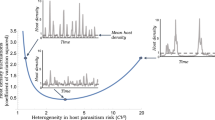Abstract
MOST environments are spatially subdivided, or patchy, and there has been much interest in the relationship between the dynamics of populations at the local and regional (metapopulation) scales1. Here we study mathematical models for host-parasitoid interactions, where in each generation specified fractions (µN and µp, respectively) of the host and parasitoid subpopulations in each patch move to adjacent patches; in most previous work, the movement is not localized but is to any other patch2. These simple and biologically sensible models with limited diffusive dispersal exhibit a remarkable range of dynamic behaviour: the density of the host and parasitoid subpopulations in a two-dimensional array of patches may exhibit complex patterns of spiral waves or spatially chaotic variation, they may show static 'crystal lattice' patterns, or they may become extinct. This range of behaviour is obtained with the local dynamics being deterministically unstable, with a constant host reproductive rate and no density dependence in the movement patterns. The dynamics depend on the host reproductive rate, and on the values of the parameters µN and µp. The results are relatively insensitive to the details of the interactions; we get essentially the same results from the mathematically-explicit Nicholon–Bailey model of host-parasitoid interactions, and from a very general 'cellular automaton' model in which only qualitative rules are specified. We conclude that local movement in a patchy environment can help otherwise unstable host and parasitoid populations to persist together, but that the deterministically generated spatial patterns in population density can be exceedingly complex (and sometimes indistinguishable from random environmental fluctuations).
This is a preview of subscription content, access via your institution
Access options
Subscribe to this journal
Receive 51 print issues and online access
$199.00 per year
only $3.90 per issue
Buy this article
- Purchase on Springer Link
- Instant access to full article PDF
Prices may be subject to local taxes which are calculated during checkout
Similar content being viewed by others
References
Gilpin, M. E. & Hanski, I. Metapopulation Dynamics: Empirical and Theoretical Investigations (Academic, London, 1991).
Taylor, A. D. Ann. Zool. Fenn. 25, 63–74 (1988).
Hassell, M. P. The Dynamics of Arthropod Predator-Prey Systems (Princeton University Press, Princeton, 1978).
Hassell, M. P. & May, R. M. J. Anim. Ecol. 42, 693–726 (1973).
Hassell, M. P. & May, R. M. J. Anim. Ecol. 43, 567–594 (1974).
Maynard Smith, J. Models in Ecology (Cambridge University Press, Cambridge, 1974).
Kareiva, P. Lect. Not. Biomath. 54, 368–389 (1984).
Kareiva, P. Nature 321, 388–391 (1989).
Kareiva, P. & Odell, G. M. Am. Nat. 130, 233–270 (1987).
Nachman, G. J. Anim. Ecol. 56, 247–265 (1987).
Nachman, G. J. Anim. Ecol. 56, 267–281 (1987).
Pacala, S., Hassell, M. P. & May, R. M. Nature 344, 150–153 (1990).
Hassell, M. P. & Pacala, S. Phil. Trans. R. Soc. 330, 203–220 (1990).
Hassell, M. P., Pacala, S., May, R. M. & Chesson, P. L. Am. Nat. 138 (in the press).
Nicholson, A. J. & Bailey, V. A. Proc. Zool. Soc. London 3, 551–598 (1935).
Chesson, P. L. & Murdoch, W. W. Am. Nat. 127, 696–715 (1986).
Murray, J. D. Mathematical Biology (Springer, London, 1989).
Hassell, M. P. & May, R. M. Ann. Zool. Fenn. 25, 55–61 (1988).
Reeve, J. D. Am. Nat. 132, 810–836 (1988).
Conway, J. H. On Numbers and Games (Academic, London, 1976).
Wolfram, S. Nature 311, 419–424 (1984).
Crawley, M. J. & May, R. M. J. theor. Biol. 125, 475–489 (1987).
Author information
Authors and Affiliations
Rights and permissions
About this article
Cite this article
Hassell, M., Comins, H. & Mayt, R. Spatial structure and chaos in insect population dynamics. Nature 353, 255–258 (1991). https://doi.org/10.1038/353255a0
Received:
Accepted:
Issue Date:
DOI: https://doi.org/10.1038/353255a0
This article is cited by
-
Mutant fixation in the presence of a natural enemy
Nature Communications (2023)
-
Complex eco-evolutionary dynamics induced by the coevolution of predator–prey movement strategies
Evolutionary Ecology (2022)
-
Endogenous spatial heterogeneity in a multi-patch predator-prey system: insights from a field-parameterized model
Theoretical Ecology (2021)
-
Dispersal-induced instability in complex ecosystems
Nature Communications (2020)
-
Dispersal-induced pattern-forming instabilities in host–parasitoid metapopulations
Nonlinear Dynamics (2020)
Comments
By submitting a comment you agree to abide by our Terms and Community Guidelines. If you find something abusive or that does not comply with our terms or guidelines please flag it as inappropriate.



